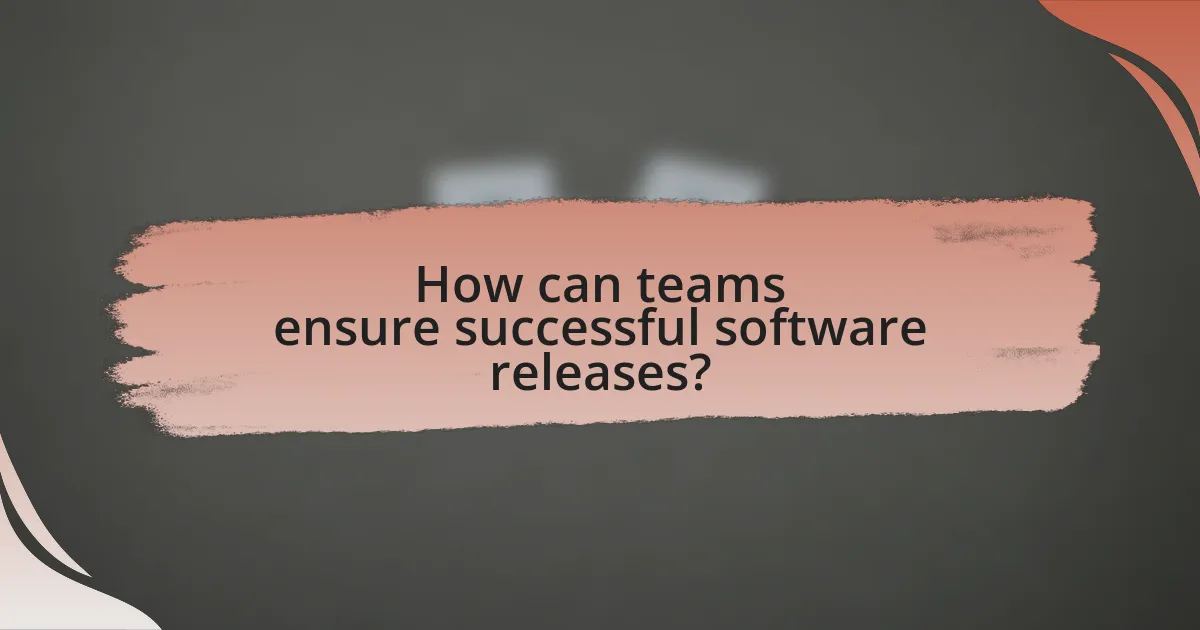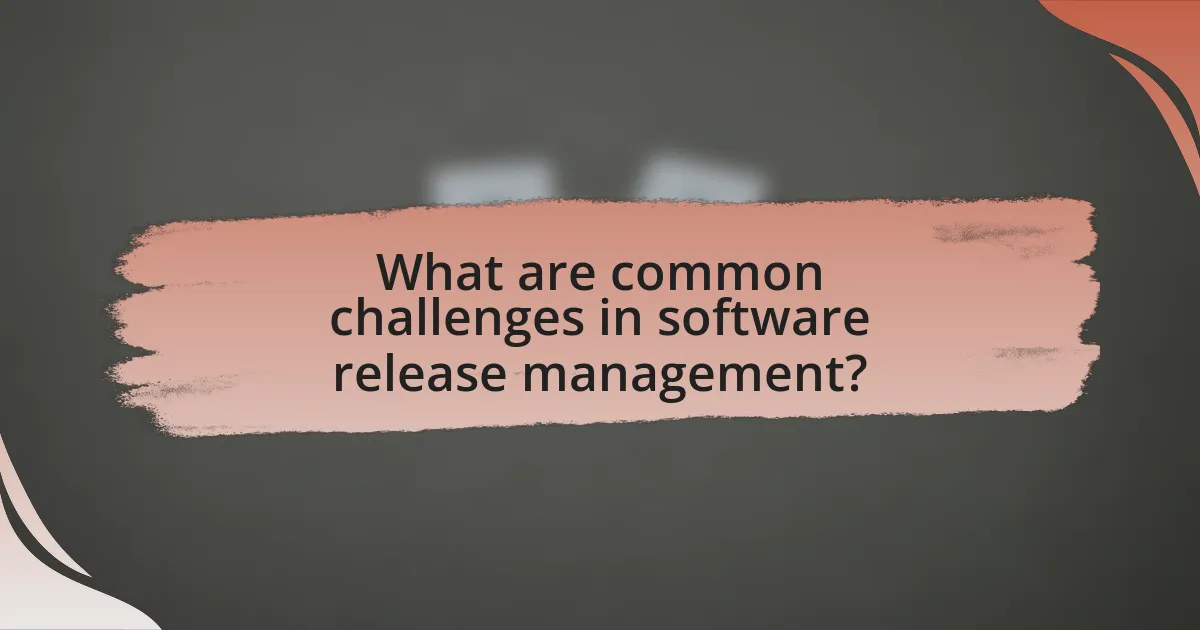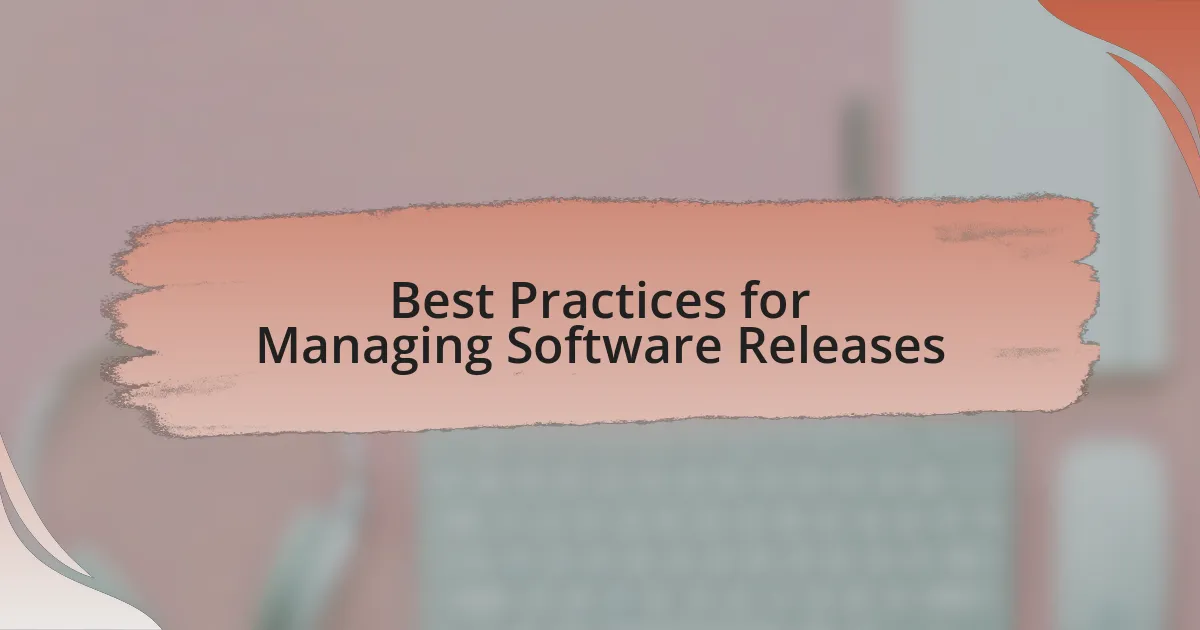The article focuses on best practices for managing software releases, emphasizing the importance of a structured release management process, version control systems, and automated testing. It outlines the significance of effective release management in delivering high-quality software while minimizing risks and disruptions. Key phases in the release management process, including planning, development, testing, deployment, and monitoring, are discussed, along with strategies for effective communication and stakeholder management. The article also highlights common challenges teams face, such as coordination and managing dependencies, and presents techniques for continuous improvement and measuring release success through relevant metrics.

What are Best Practices for Managing Software Releases?
Best practices for managing software releases include establishing a clear release management process, utilizing version control systems, and implementing automated testing. A structured release management process ensures that all stakeholders understand the timeline and responsibilities, which reduces confusion and enhances collaboration. Version control systems, such as Git, allow teams to track changes, manage code versions, and facilitate collaboration among developers. Automated testing, including unit tests and integration tests, helps identify issues early in the development cycle, ensuring higher quality releases. According to the 2021 State of DevOps Report, organizations that implement these practices experience 208 times more frequent deployments and 106 times faster lead times from commit to deploy, demonstrating the effectiveness of these best practices in improving software release management.
Why is effective software release management important?
Effective software release management is important because it ensures the timely delivery of high-quality software products while minimizing risks and disruptions. By implementing structured release processes, organizations can coordinate development, testing, and deployment activities, which leads to improved collaboration among teams. According to the 2021 State of DevOps Report, organizations with effective release management practices experience 2.5 times more frequent deployments and 60 times fewer failures, demonstrating that proper management directly correlates with enhanced performance and reliability in software delivery.
What risks are associated with poor software release management?
Poor software release management poses several significant risks, including increased likelihood of software defects, deployment failures, and security vulnerabilities. These risks arise from inadequate planning, insufficient testing, and lack of coordination among development teams. For instance, a study by the Standish Group found that poorly managed software projects are 50% more likely to fail due to defects and misalignment with user requirements. Additionally, a report from IBM indicates that organizations with poor release management practices experience 30% more security incidents, as untested code can introduce vulnerabilities. These statistics underscore the critical importance of effective release management in mitigating risks associated with software development.
How does effective release management improve software quality?
Effective release management improves software quality by ensuring systematic planning, execution, and monitoring of software releases. This structured approach minimizes the risk of defects and enhances the reliability of the software. For instance, organizations that implement continuous integration and continuous deployment (CI/CD) practices report a 30% reduction in release-related defects, as these practices facilitate early detection of issues. Furthermore, effective release management incorporates thorough testing and validation processes, which contribute to higher user satisfaction and fewer post-release bugs. By maintaining clear communication among stakeholders and adhering to defined release schedules, teams can better manage expectations and deliver high-quality software consistently.
What are the key phases in the software release management process?
The key phases in the software release management process are planning, development, testing, deployment, and monitoring. Planning involves defining the scope and objectives of the release, ensuring alignment with business goals. Development encompasses coding and integrating new features or fixes. Testing is critical for validating the software’s functionality and performance, often involving automated and manual testing methods. Deployment refers to the actual release of the software to production environments, which may include strategies like blue-green deployments or canary releases. Finally, monitoring involves tracking the software’s performance post-release to identify any issues and gather user feedback for future improvements. Each phase is essential for ensuring a successful software release that meets quality standards and user expectations.
What activities are involved in the planning phase?
The activities involved in the planning phase of software releases include defining project scope, identifying resources, creating a timeline, and risk assessment. Defining project scope establishes the objectives and deliverables, ensuring all stakeholders have a clear understanding of what the project entails. Identifying resources involves determining the necessary personnel, tools, and budget required for successful execution. Creating a timeline outlines key milestones and deadlines, facilitating effective scheduling and coordination. Risk assessment identifies potential challenges and develops mitigation strategies, enhancing the project’s resilience. These activities collectively ensure a structured approach to managing software releases, leading to improved outcomes and stakeholder satisfaction.
How do testing and validation fit into the release process?
Testing and validation are critical components of the release process, ensuring that software meets quality standards before deployment. They involve systematically evaluating the software to identify defects and verify that it fulfills specified requirements. Testing typically includes unit tests, integration tests, and system tests, while validation confirms that the software meets user needs and expectations. According to the 2021 State of DevOps Report, organizations that implement rigorous testing and validation practices experience 2.5 times more frequent code deployments and 60% lower change failure rates, demonstrating the effectiveness of these practices in enhancing software reliability and performance.
What tools and methodologies support software release management?
Tools and methodologies that support software release management include Continuous Integration/Continuous Deployment (CI/CD) tools, version control systems, and Agile methodologies. CI/CD tools like Jenkins, GitLab CI, and CircleCI automate the process of integrating code changes and deploying applications, ensuring faster and more reliable releases. Version control systems such as Git enable teams to track changes, collaborate effectively, and manage code versions, which is crucial for maintaining software quality. Agile methodologies, including Scrum and Kanban, facilitate iterative development and allow teams to adapt to changes quickly, enhancing the overall release management process. These tools and methodologies collectively streamline workflows, reduce errors, and improve collaboration among development and operations teams.
How do Agile and DevOps practices enhance release management?
Agile and DevOps practices enhance release management by promoting continuous integration and delivery, which streamline the software release process. Agile methodologies emphasize iterative development and frequent feedback, allowing teams to adapt quickly to changes and deliver incremental updates. DevOps complements this by fostering collaboration between development and operations teams, automating deployment processes, and ensuring that code is always in a deployable state. This integration results in shorter release cycles, reduced risk of errors, and improved overall quality of software releases. For instance, organizations that implement DevOps practices report up to 46 times more frequent deployments and 96 times faster recovery from failures, demonstrating the effectiveness of these practices in enhancing release management.
What role do automation tools play in managing software releases?
Automation tools play a critical role in managing software releases by streamlining processes, reducing human error, and increasing deployment speed. These tools automate repetitive tasks such as code integration, testing, and deployment, which enhances efficiency and consistency in the release process. For instance, continuous integration and continuous deployment (CI/CD) pipelines utilize automation tools to ensure that code changes are automatically tested and deployed, allowing for faster feedback and quicker iterations. According to a 2021 report by the DevOps Research and Assessment (DORA), organizations that implement automation in their release processes can achieve 46 times more frequent deployments and 96 times faster recovery from failures, demonstrating the significant impact of automation tools on software release management.

How can teams ensure successful software releases?
Teams can ensure successful software releases by implementing a robust release management process that includes thorough planning, testing, and communication. Effective planning involves defining clear objectives, timelines, and responsibilities, which helps align team efforts. Comprehensive testing, including unit, integration, and user acceptance testing, identifies and mitigates potential issues before deployment. Additionally, maintaining open lines of communication among team members and stakeholders fosters collaboration and ensures everyone is informed of progress and changes. According to the Standish Group’s CHAOS Report, projects with effective communication and stakeholder involvement have a 70% higher success rate, underscoring the importance of these practices in achieving successful software releases.
What strategies can be implemented for effective communication during releases?
Effective communication during software releases can be achieved through several strategies, including establishing clear communication channels, utilizing release notes, and conducting regular status updates. Clear communication channels, such as dedicated Slack channels or project management tools, ensure that all team members can access information quickly and efficiently. Release notes provide a concise summary of changes, features, and fixes, allowing stakeholders to understand the impact of the release. Regular status updates, whether through meetings or emails, keep everyone informed about progress and any potential issues, fostering transparency and collaboration. These strategies are supported by industry practices that emphasize the importance of communication in successful software deployment, as highlighted in the Agile Manifesto, which prioritizes customer collaboration and responsiveness to change.
How can teams manage stakeholder expectations throughout the release process?
Teams can manage stakeholder expectations throughout the release process by maintaining clear and consistent communication. Regular updates on project progress, potential risks, and changes in timelines help stakeholders stay informed and aligned with the project’s status. For instance, utilizing tools like project management software can facilitate transparency, allowing stakeholders to track milestones and deliverables in real-time. Research indicates that effective communication can reduce misunderstandings and enhance stakeholder satisfaction, as evidenced by a study from the Project Management Institute, which found that projects with high stakeholder engagement are 20% more likely to succeed.
What are the best practices for documenting release notes?
The best practices for documenting release notes include clarity, conciseness, and consistency. Clear language ensures that all stakeholders understand the changes made, while concise descriptions help in quickly grasping the essential updates. Consistency in format and terminology across release notes aids in maintaining a professional standard and makes it easier for users to find relevant information. Additionally, categorizing changes into sections such as new features, bug fixes, and improvements enhances readability. According to a study by the Software Engineering Institute, well-documented release notes can reduce user confusion and support requests by up to 30%, demonstrating the importance of effective communication in software releases.
How can teams mitigate risks during software releases?
Teams can mitigate risks during software releases by implementing thorough testing protocols, utilizing automated deployment processes, and maintaining clear communication among stakeholders. Comprehensive testing, including unit, integration, and user acceptance tests, ensures that potential issues are identified and resolved before deployment. Automated deployment reduces human error and increases consistency, as evidenced by studies showing that organizations using automation experience 60% fewer failures. Additionally, regular communication among developers, testers, and project managers fosters a shared understanding of project goals and potential risks, which is crucial for timely issue resolution.
What contingency plans should be in place for potential release failures?
Contingency plans for potential release failures should include rollback procedures, automated monitoring, and communication strategies. Rollback procedures allow teams to revert to the previous stable version quickly, minimizing downtime and user impact. Automated monitoring tools can detect issues in real-time, enabling prompt responses to failures. Communication strategies ensure that stakeholders are informed about the status of the release and any necessary actions, which is critical for maintaining trust and transparency. Implementing these plans is essential, as studies show that 70% of software projects experience significant issues during release, highlighting the need for effective contingency measures.
How can teams conduct post-release reviews to learn from mistakes?
Teams can conduct post-release reviews by systematically analyzing the release process, identifying issues, and documenting lessons learned. This involves gathering data on performance metrics, user feedback, and any incidents that occurred during or after the release. By holding a structured review meeting, teams can discuss these findings, categorize mistakes, and prioritize actionable improvements. Research indicates that organizations that implement regular post-release reviews can reduce future errors by up to 30%, as they create a culture of continuous improvement and accountability.

What are common challenges in software release management?
Common challenges in software release management include coordination among teams, managing dependencies, ensuring quality, and adhering to timelines. Coordination among development, operations, and quality assurance teams is often difficult, leading to miscommunication and delays. Managing dependencies between different software components can complicate the release process, as changes in one area may impact others. Ensuring quality through testing is critical, yet it can be challenging to balance thorough testing with the need for timely releases. Adhering to timelines is another significant challenge, as unexpected issues can arise, causing delays and impacting project schedules. These challenges are frequently cited in industry reports, such as the 2021 State of DevOps Report, which highlights the importance of effective collaboration and automation in overcoming these obstacles.
What obstacles do teams face when coordinating releases across multiple teams?
Teams face several obstacles when coordinating releases across multiple teams, including communication breakdowns, differing priorities, and integration challenges. Communication breakdowns often occur due to the lack of a unified platform for sharing updates, leading to misunderstandings about timelines and responsibilities. Differing priorities among teams can result in conflicts over resource allocation and scheduling, making it difficult to align on release goals. Integration challenges arise when teams use different tools or technologies, complicating the merging of code and features. These obstacles can delay releases and impact overall project success, as evidenced by studies showing that poor communication can lead to project overruns by up to 30%.
How can teams address conflicts in release schedules?
Teams can address conflicts in release schedules by implementing clear communication and prioritization strategies. Establishing regular meetings allows team members to discuss potential conflicts and align on priorities, ensuring that everyone is aware of deadlines and dependencies. Utilizing project management tools can help visualize timelines and identify overlapping tasks, which facilitates better planning. According to a study by the Project Management Institute, effective communication can improve project success rates by up to 20%, highlighting the importance of addressing conflicts proactively.
What strategies can help manage dependencies between software components?
To manage dependencies between software components effectively, implementing modular architecture is essential. Modular architecture allows for the separation of components, enabling independent development, testing, and deployment. This strategy reduces the risk of cascading failures and simplifies updates, as changes in one module do not necessitate changes in others. Additionally, using dependency management tools, such as Maven or npm, can automate the tracking and resolution of dependencies, ensuring that all components are compatible and up-to-date. These tools provide version control and help maintain a clear overview of dependencies, which is crucial for large projects. Furthermore, adopting continuous integration practices facilitates early detection of dependency issues, allowing teams to address them promptly before they escalate into larger problems.
How can teams adapt to changing requirements during the release process?
Teams can adapt to changing requirements during the release process by implementing agile methodologies, which emphasize flexibility and iterative development. Agile practices, such as regular sprint reviews and backlog grooming, allow teams to reassess priorities and incorporate new requirements based on stakeholder feedback. Research indicates that organizations using agile frameworks can respond to changes 30% faster than those using traditional methods, as reported in the “State of Agile” survey by VersionOne. This adaptability is further enhanced by maintaining open communication channels among team members and stakeholders, ensuring that everyone is aligned on project goals and changes.
What techniques can be used to prioritize features effectively?
Techniques to prioritize features effectively include the MoSCoW method, the Kano model, and the Weighted Scoring model. The MoSCoW method categorizes features into Must have, Should have, Could have, and Won’t have, allowing teams to focus on essential features first. The Kano model assesses features based on customer satisfaction and functionality, helping to identify which features will delight users versus those that are basic expectations. The Weighted Scoring model assigns numerical values to various criteria such as cost, value, and risk, enabling a quantitative approach to prioritize features based on their overall impact. These techniques are widely used in agile and product management practices, ensuring that development efforts align with user needs and business goals.
How can teams remain flexible while maintaining release timelines?
Teams can remain flexible while maintaining release timelines by implementing agile methodologies that prioritize iterative development and regular feedback. Agile practices, such as Scrum or Kanban, allow teams to adapt to changes quickly while ensuring that they meet their deadlines. For instance, using sprints enables teams to focus on short-term goals, reassess priorities, and adjust workloads based on real-time feedback. Research shows that organizations employing agile practices can increase their delivery speed by up to 30%, demonstrating that flexibility and timely releases can coexist effectively.
What are the best practices for continuous improvement in release management?
The best practices for continuous improvement in release management include implementing automation, fostering collaboration, and utilizing metrics for performance evaluation. Automation streamlines repetitive tasks, reducing errors and increasing efficiency; for instance, automated testing can significantly decrease the time required for quality assurance. Collaboration among development, operations, and quality assurance teams enhances communication and alignment, leading to smoother releases. Utilizing metrics, such as deployment frequency and lead time for changes, allows teams to assess their performance and identify areas for improvement. According to the 2021 State of DevOps Report, high-performing teams that adopt these practices can achieve 46 times more frequent deployments and 440 times faster lead time for changes, demonstrating the effectiveness of these continuous improvement strategies in release management.
How can teams implement feedback loops to enhance future releases?
Teams can implement feedback loops to enhance future releases by establishing regular communication channels for collecting user feedback and integrating it into the development process. This can be achieved through methods such as surveys, user testing sessions, and monitoring analytics to gather insights on user experience and product performance. For instance, a study by the Nielsen Norman Group highlights that iterative user testing can lead to a 50% improvement in usability, demonstrating the effectiveness of incorporating user feedback. By analyzing this feedback, teams can identify areas for improvement, prioritize features, and make data-driven decisions that align with user needs, ultimately leading to more successful software releases.
What metrics should be tracked to measure release success?
To measure release success, key metrics include deployment frequency, lead time for changes, mean time to recovery (MTTR), change failure rate, and customer satisfaction. Deployment frequency indicates how often new releases are delivered, reflecting the team’s efficiency. Lead time for changes measures the time taken from code commit to deployment, highlighting the speed of the development process. MTTR assesses the average time taken to recover from a failure, which is crucial for understanding system reliability. Change failure rate tracks the percentage of changes that result in failures, providing insight into the quality of releases. Finally, customer satisfaction gauges the end-user experience and acceptance of the release, which is essential for overall success. These metrics collectively provide a comprehensive view of the effectiveness and impact of software releases.

Leave a Reply